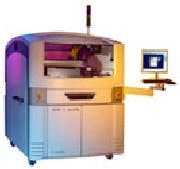Surface-Mount Printer Builder Bases New Machine on User Input
Jim Montague is the executive editor for Control. Email him at [email protected].
Juggling is all about keeping appointments. Visual, tactile and other sensory data help jugglers’ brains tell their hands where to go, when to be on time, and how to catch and throw when they get there. Practice literally creates and strengthens neural pathways, which combine many separate tasks in the novice’s head into one or two fluid moves in the expert’s mind.
Motion control engineers managing multiple axes and/or servo-based applications know these jobs only too well, and few more so than surface-mount printer (SMP) users. Consequently, they understand that better information and faster networking means greater motion accuracy and efficiency, and so they continually demand it from their machines and builders.
To fulfill these ongoing needs, Speedline Technologies (Franklin, Mass.) recently launched its new MPM Accela stencil printer, which uses parallel-processing technology and CANopen networking reportedly to produce 20-80% more and better-quality circuit boards per hour than other printers. The firm adds Accela includes 11 newly patented or patent-pending technology concepts.
Introduced in June 2005, Accela replaces Speedline’s previous flagship product, UltraFlex, which reportedly had more capability than any other SMP when it debuted in 1995, such as better changeover and automatic pin placement. However, after three subsequent UltraFlex upgrades and iterations, Speedline decided it was time to develop a new product.
“You come to a point when you have to decide whether to continue upgrading or create something new. Machine builders usually iterate until either customers’ demands can’t be met or cost-effectiveness diminishes or obsolescence becomes a factor, and we were beginning to see a combination of them showing up on our customers’ road maps,” says Bob Boyes, Speedline’s product marketing manager. "Many users must now produce lead-free, ultra-fine pitch assemblies of components on circuit boards, and their density needs are requiring them to install more and more devices per board.
There's also a lot of change and demand for improved capabilities in the markets that use these boards. For example, automotive applications are adding far more electrical content per car, cell phone markets are continuing their huge growth, and we’re also seeng more used in contract manufacturing, medical and other industrial applications.”
MPM Accela stencil printer uses parallel processing and CANopen to produce more and better circuit boards.
In fact, recently implemented, Europe-based Restriction of Hazardous Substances (RoHS) rules force changes on the physics required in surface-mount technology (SMT). This is because lead-free solder doesn’t flow as easily as traditional lead paste, and so greater accuracy is needed when depositing and heating to make sure it flows correctly onto the leads and pads on its computer boards.
Presently, SMT paste has to be deposited with an accuracy of 0.002 in. Accela reportedly can deposit it within 0.001 in.
“To achieve the improved accuracy and throughput required, we realized that some of the mechanical structures in our existing printing platforms would have to change,” says Boyes. “For instance, when our previous machine shuttled boards, the whole frame would vibrate. Accela has a polymer base that handles sonic damping much better, so boards can be aligned and prepared for printing much quicker. One customer that used to produce 1,300 boards per shift is using Accela to run 1,700 per shift.
While seeking these improvements during Accela’s design and development, Speedline’s engineers realized that some physical and electronic aspects of the new printer were going to run into each other. “We could only run so many axes of motion within the machine before, basically four cards with four axes each. Even multiplexer cards with three functions sould only run one at a tme.”
Consequently, Speedline redesigned its machine footprint for Accela to eliminate mechanical interference, and implemented CANopen to allow all its components to potentially run at the same time. “”We now have 18 axes of intelligent, distributed control, and each axes know where all the others are located, says John Klauser, Speedline’s controls engineer. “Previously, every motion occurred serially, and had to finish before the next motion could happen. Now, constant monitoring of all axes allows the second motion to occur when the first is just enough out of the way for the second to go.”
The two high-functioning CPUs that enable Accela’s motion control and a digital camera also assist in the “alignment of fiducial” process when the board and stencil planes meet, so the image cut into the stencil will match the proper pad location on the substrate. After the paste is applied, the CPUs and camera also inspect to make sure it was done properly. In the paste, inspections were gated by the amount of CPU power available.
“Because control in Accela is independent, the CPU just tells the controller to go do its job, but it doesn’t have to say how,” add Boyes. “The controller at the motor uses its CANopen, servo drives and steppers to run the lower-level commands that don’t require constant monitoring by the host CPU. This eliminates much of the mechanical interference, electrical access management, and CPU access management that had been problems before.”
Besides improving its aligning, printing, and inspecting, CANopen also helps Accela clean its stencils. Previously, board and stencil alignment and the cleaning wiper had to work in the same plane and risk collisions, but Accela send stencils back to a wiper station for cleaning, which prevents collisions. In fact, CANopen even allows the camera to perform board inspection while the wiper is running, or enable the machine to add paste to the top side of the stencil while it cleans the bottom. All of this coordination saves time, and allows another Speedline customer reportedly to use Accela to reduce its print, wipe, and dispense process from 51 sec. per board to 22-23 sec. Speedline’s prior SMP average throughput was 27 sec., and now Accela’s rate is 13-14 sec., which allows time for more frequent inspections.
Klauser and Boyes say users' other future demands may include added traceability, barcodes and process verification to make even more sure that the boards have every component they’re supposed to have before they’re produced, that the printer is running the right program, and that stencils are inspected before printing to ensure that no problems are going to develop soon. “It isn’t just working with small components, but it’s being able to do so reliably,” says Klauser. “Accela delivers on what the future is going to require.”
About the Author
Jim Montague
Executive Editor, Control
Jim Montague is executive editor of Control. He can be contacted at [email protected].

Leaders relevant to this article:


